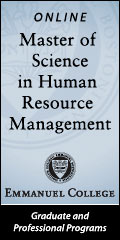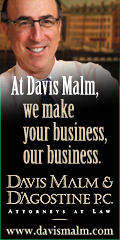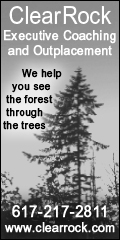NEHRA News
Northeast Human Resources Association
The more we are consciously in sync with what I call "The Life Force," the faster, more targeted and powerful are our actions. Like an athlete "In The Zone," we accelerate our performance with grace and ease.
Imagine how difficult life would be if you are not aware of these flows. Many of us are not. It would be like hiking through a wilderness fog without a compass. Even if you knew you needed to go North, you could not tell which way it is. Likewise, we need an "Inner Compass" to navigate within the flows of cause and effect that influence every moment of our lives, a way to understand where we are, and where the flow of history is going. But what is, and what is the practical use of, our inner compass? A story best illustrates.
What Is Your Inner Compass?
Many came to me, as Don’s coach, to suggest I persuade him of the foolishness of his actions. I explained that I was his leadership coach and had little knowledge of the financial markets, but encouraged them to speak directly to Don. However, no matter how people pleaded, he would not change course. Several key players resigned and went to more "progressive" companies.
A week or so later, I asked Don how he knew to pull all of the company's investments out of the stock market three months before the October 1987 crash. He said, "I just knew it couldn't last." Everyone in his world thought he was wrong, yet he had the wisdom and courage to do what he felt was right.
Knowing the Difference
Don Ross explained to me, "The key to wisdom is to know the difference between your wild hopes and fears and common sense, intuition or true wisdom." They often seem the same, but they are not. There is a distinct difference in the feeling. One comes from the ego and insecurity, and the other comes from wisdom. Great leaders learn the difference and, given this knowledge, develop the courage to act quickly. Don had found ways to live in the present like an athlete "In the Zone," but with an easier more sustainable feeling I call "Integrative Presence," or at least he was able to find that state of mind when he needed insight. When I met with him over the years, he was often in the state of Integrative Presence. He was warm, yet seemed to be able to see through people. Insightful, yet he moved with grace and ease.
Courage To Act
Know How It Feels
It Is a Natural State of Mind
Sports create highly charged environments. They are designed to bring out the best in people. But can this state be achieved outside this arena? Certainly, if these states of mind that seem to create superhuman results can be created in one area of life, they should be able to be created in others. While the environment is particularly right for this kind of performance in sports, it is not beyond or separate from this "real world" we all operate within.
The Present Is the Only Portal to the Future?
The band, which represents "The Life Force," naturally lures people onto the floor to dance in a rhythm and harmony that seems to come from outside them. Of those out on the floor, many dance out of rhythm most of the time, but have moments of grace. Others have a routine that they have worked out over the years which works for them, but only captures a small part of the rhythm. Some have a routine and experiment momentarily with new movements, but mostly go back to what they know. Those who feel the music deeply dance adding rhythms and counter rhythms and seem to be an extension of "The Life Force" that passes through the band.
Without knowing, many start to follow the waves of energy coming from the leaders and the overall quality of the dance improves. At some point in time, magic occurs. The beauty and energy of the lead dancers is so compelling that the band itself is drawn into the dance creating new rhythms and flows as the Life Force, the band, and the dancers join and create new realities.
Start with the Present Moment
"The Life Force" creates life and life influences "The Life Force," just as the band creates the rhythm and flow and changes, because the lead dancers’ energy becomes part of the rhythm and flow. The only way to create the future is to engage, like the dancers, with the rhythm and flow of the present; and by doing so you become a co-creator. It is not about wishing and hoping as the popular book The Secret would suggest. The various rhythms and flows of business markets are subsets of the rhythm and flow of "The Life Force," which animates everything. Both can be influenced in the manner just described. Great leaders have discovered and mastered this secret.
There Is No Substitute for Practice
Your inner compass lets you know the difference between your thoughts about the flow of cause and effect, and the actual flow. We have to practice to know the difference between the feelings that come from our thoughts and ego and our natural wisdom. Knowing how to access our natural wisdom is the inner compass. Having this compass helps us walk with the wind of "The Life Force" at our backs and in our hearts.
About the Author:
When I was working as a leadership consultant to Don Ross, Chairman and CEO of New York Life, during the summer of 1987, many people were coming to me questioning the Chairman’s actions. He had asked the investment department to slowly move all investments out of the stock market into conservative investments. This frustrated his investment team because the stock market was at an all time high and their competitors were using "High Yield Bonds" and stocks to create gains much greater than New York Life’s. They wanted to play in the game, and Don Ross was telling them to step back.
In October of 1987, while I was on site at New York Life, the market crashed. It was the biggest crash since the Great Depression. But New York Life had moved most of its investments out of the stock market and had not invested in any "High Yield Bonds," known later as "Junk Bonds." Don Ross was now considered a genius. The financial gain was enormous.
When I pressed him to tell me more, he went on to explain that, as Chairman and CEO, he was continuously bombarded with "experts" trying to convince him of completely different strategic directions. Each had incredible credentials and a good story, yet each recommended different directions. The only tool he had to make the final decision was his instinct, or intuition. He said, "Whenever I have gone against my intuition, I have regretted it."
All the great leaders I have worked with know how to achieve the state of Integrative Presence, even though they may not understand the nature of this state of mind. They have experienced being connected to something that supercharges their own knowledge. They speak reverently about this connection in private, but rarely talk about it to the press. It just seems too outside the norm for stockholders and the public. But knowing and connecting to wisdom through Integrative Presence is essential for leaders in business today. Markets move quickly, often with little warning, and the wise leader can feel the moving currents. At each moment, like a surfer, the conscious leaders are so present they take advantage of trends as they emerge.
When I have asked people to describe how they feel when they experience being "In The Zone" or Integrative Presence, they say things like: confident, at peace, exhilarated, powerful, graceful, and present. Some report a slow motion effect as time slows. Kareem Abdul-Jabbar told how the five seconds he had to win the NBA championship with one shot seemed like five minutes. He felt relaxed, as if he had all the time in the world, yet he appeared to move like lightning to the rest of the world—the very definition of Integrative Presence. His creativity, within these few precious seconds, was nothing less than pure genius. He was integrating the skills he had learned over the years, his desire to make the shot, and the flow of the moment.
As I have experienced and studied athletes in the zone or integrative presence. I have found that this state of mind, though not often reached, is a natural way of living. It seems we have lost touch with true presence overtime. Ironically, the art of getting into this state of mind is letting go of what we think we know. As you let go, this state of mind just takes over. You don’t need to train yourself to experience Integrative Presence, you merely need to "let go." This state takes over your consciousness and supercharges your performance because it is in our nature to live this way.
You might ask, "If you are in the present, "How do you create the future?" Here is my answer. Imagine the world is a dance floor and the rhythm and flow of the band is "The Life Force," which infuses everything. The multidimensional flow of the band seems irresistible to some, yet others stand against the wall not knowing how to jump in, and many are not even aware of the dance. They have heard people talk about it, but can’t seem to hear or feel the flow of the music. Those who feel it deeply dance like gods and goddesses in the middle of the floor creating a vortex of energy and motion that draws new dancers into their circle.
The flow of market wants and needs is like the complex themes, harmonies, and rhythms in music. Your team must spend lots of time dancing with those rhythms to know how to influence the flow of the dance. Your team, products and services must dance first with the rhythm and flow of the present, then lead. There is no substitute for this kind of presence in your target market, and like dancing to a good band, or being in "The Zone" in sports, it is a blast! The energies of the market will feed you and your creativity will lead the flow of the market.
Paul David Walker, Founder & CEO of Genius Stone Partners, was part of building the first leadership firm to align Strategy, Structure and Culture, and has been a business leadership adviser to the CEOs of Fortune 500 and midsized companies for over 25 years. He is the author of Unleashing Genius: Leading Yourself, Teams and Corporations, and two other books. He has succeeded by unleashing the genius of the people around him and is known to be a visionary leader and master of collaboration. Paul brings a special energy that calms people and brings teams together. He has been, and is, mentored by some of the most profound philosophers and spiritual leaders of our time. His email is pauldavidwalker@geniusstone.com and website, www.geniusstone.com.
At the same time, the line between personal and private time is getting increasingly blurred as more people telecommute, bring their laptops home with them to work after hours, and stay in touch with the office virtually around the clock through technology. By their design, social media sites foster a blend of the professional and the personal. On any given user profile, a person is likely to have contacts ranging from college roommates to current clients and colleagues to old flames.
Given their ambiguous nature, social media sites can create a tricky confluence of factors in the workplace. It can be challenging for HR managers and company leaders to develop a policy that satisfies employees, allows people to access the benefits of the technology, and protects the company from the dark side of these sites. Here are five things HR managers should consider when putting together a social media strategy:
No Policy Is a Risky Policy
Some HR managers, so overwhelmed by the complexity of regulating the use of these sites, try to crawl into their proverbial caves and pretend the technology doesn’t exist. Others leave it up to individual managers, and still others believe that employees can police themselves ("We trust our employees to make appropriate choices.") Unfortunately, not having a policy can expose the organization to an embarrassing incident, bad publicity or even legal action. There are currently several law suits working their way through the courts involving people who have sued their former employers after being terminated because of a post on a social media site. While it is noble to trust employees, some people—especially if they are new to a site—may not know how to use the technology appropriately. All it takes to create a potentially cringeworthy situation is one novice user posting in the wrong place.
Blocking Sites May Hurt the Organization
Other HR managers address the challenge by blocking these sites from the company’s server. Of course, this action comes with its own risks. By cutting access to these networking sites, organizations may also be turning away business. Many companies attribute a significant portion of their annual sales to these sites, and some organizations request that their employees maintain LinkedIn and Twitter accounts. Blocking these sites can also put your company at a hiring disadvantage as they can be valuable recruiting tools.
A Policy Should Be Explicit and Specific
It only takes one employee who doesn’t understand the ramifications of using a social networking site incorrectly to put the company at risk. Assume everyone knows nothing when developing your policy. Be specific about the dos and don’ts for employees. Some questions you might want to consider are: Can employees list the company as their workplace? Can they befriend clients and vendors? Can they post about clients, vendors, colleagues or the competition? Give examples of what is okay and what is off-limits. Also let employees know the consequences of inappropriate actions. Having a policy also takes the pressure off employees who may not know what is expected of them when it comes to how they should be using these sites at work.
Define Private
Many people are under the impression that what they do (or post) during their personal time with their personal computer remains private. Remind employees that posting on public forums is never private. Cyber-bullying a coworker or badmouthing a manager, direct report or the organization on the internet is akin to writing the message in spray paint on the office building and signing your name. Just because the action took place after hours and the person supplied the can of spray paint, it is still an attack on the company. Employees need to know that they will be held accountable for what they post on these sites, and that company representatives will be checking sites periodically.
Give Employees the Tools to Use Social Media Effectively
You wouldn’t put employees on a manufacturing floor without being trained in how to use the heavy machinery. The same philosophy applies to social media sites. Organizations can take advantage of the vast business potential of these sites, but they must give employees the training they need to do it properly.
There is tremendous opportunity for organizations to tap into social media websites to increase their profits. With new users joining every day, it seems irresponsible for companies not to take advantage of this growing potential pool of customers, clients, and future employees. Yet, these sites can be dangerous because with the click of a mouse, employees can broadcast any message or photo they choose across the internet. HR managers can help their organizations utilize these sites while mitigating risk by creating a detailed policy for employees to follow and giving them the training they need to use the sites correctly. By giving employees reign to use the sites at work along with education and guidelines, they can post, link and tweet their way through cyberspace while growing the business as well.
About the Author: Elaine Varelas is Managing Partner at Camden Consulting Group, a division of Keystone Partners and a provider of integrated talent management solutions for organizational and leadership development, and has over 20 years of career development and HR experience. She also serves on the board of directors for Career Partners International, the world's largest career management partnership. To learn more about integrated talent management solutions, visit www.camdenconsulting.com.
Also, Tom just received his "Global Career Development Facilitator" Certificate through the National Career Development Association.
Congratulations Tom!
It will also ensure that your information is correct in the Member Directory. Once you log in, go to the "About NEHRA" tab and select Membership Directory and then click on Update my Membership Profile.
While you are updating your profile, you might want to consider joining one of the Community Forums or adding your name to one of the Listservs. An updated profile and connecting to one of the NEHRA Communities is a great way to maximize your membership and create your personal network.
If you need help with this process please do not hesitate to contact Carole Edson, Director of Membership, at cedson@nehra.com.
The Community Forums offer:
- Opportunities to network with other NEHRA members on a regular basis
- Opportunities to develop leadership skills
- Opportunities to share useful information and best practices within the Community Forum content area
Currently NEHRA has nine active Forums (click HERE for more info) and is eager to work with members to create more. Specifically we are looking for members interested in helping to form a Benefits Community Forum.
If you have ideas for other Forums and are interested in helping us to pull a group together please contact Carole Edson, Director of Membership, at cedson@nehra.com.
- To become a fan of NEHRA on Facebook, CLICK HERE.
- If you are already a member of LinkedIn, CLICK HERE to join the NEHRA LinkedIn Community!
If you are not already a member of LinkedIn, you will need to follow the easy steps to create your profile. Once your profile is completed you can follow the steps below to become a member of the Northeast Human Resources Group.
- Find the tab for "Groups" on your home page and select "Group Directory."
- Use the search function in the upper right and type in "Northeast Human Resources Association."
- Click on "Join this Group."
- This will bring you to a description of the group and you will be asked to make selections about your preferences for display the group logo on your personal page.
- Enter a contact e-mail address, a digest e-mail address, delivery frequency, announcements and messages.
- Once you have made these choices click the button "Join Group."
- Your message will come to the NEHRA Group Administrator to verify membership and approve you for the group.
To Join a Community Forum Subgroup on LinkedIn
- Once you are a member of the Northeast Human Resources Group, select "Subgroups."
- Select all the groups you are interested in joining.
- Your request goes to the NEHRA Group Administrator for approval.
- You will receive a message that you are a member of this subgroup and you can begin to read and post information on the Subgroup page.
Current NEHRA Subgroups
- Learning and Development Community Forum
- Diversity and Inclusion Community Forum
- Consultants Community Forum
- Small Business HR Community Forum
- HR Technology Community Forum
- Talent Acquisition Community Forum
- Flexible Workplaces Community Forum
As you may know, NEHRA is continuing to evolve to better meet the needs of members. Therefore, we have created a new membership category: Group Membership.
This category is created to recognize the need, and often the desire, of many organizations to control spending and manage membership expenses for their employees.
What does this really mean for you? It means that if your company has five or more current members, you could experience a savings of 10 percent or more on the total cost of these NEHRA memberships through Dec. 31, 2011. In addition, the group membership allows you to renew all memberships at the same time—reducing the hassle and workload of individual renewal dates. Finally—and perhaps most importantly—it ensures that all members of your team have access to programming, to our new webinars, to resources and information at our website and to networking and professional development opportunities.
- How does the program work? All current members from your organization are renewed on a pro-rated basis—based on the individual membership type (NEHRA or NEHRA/SHRM), to bring them to a common renewal date, Dec. 31. Any new members are added and pro-rated, based on a Dec. 31 end date. The entire group is then renewed for another full year, based on this common renewal date.
- Can I add new members? New members can be added to your group at any time during your membership cycle, and their membership will be pro-rated to maintain them on the single renewal date.
- What if someone leaves? You can easily transfer that membership to another employee within your team, with one quick call.
- How does the membership work? Each group member is assigned an individual membership number, allowing them to access information on www.nehra.com and to register for events, webinars and professional development throughout the year.
This is an exciting new opportunity for you to expand access to NEHRA and save money!
If you are interested in learning more about the group membership or getting a quote for your group, please contact Carole Edson, Director of Membership and Alliances, at (781) 239-8705 or cedson@nehra.com.
For more information or to sign up for this opportunity, contact the NEHRA office today at (781) 235-2900 or via email at info@nehra.com.



